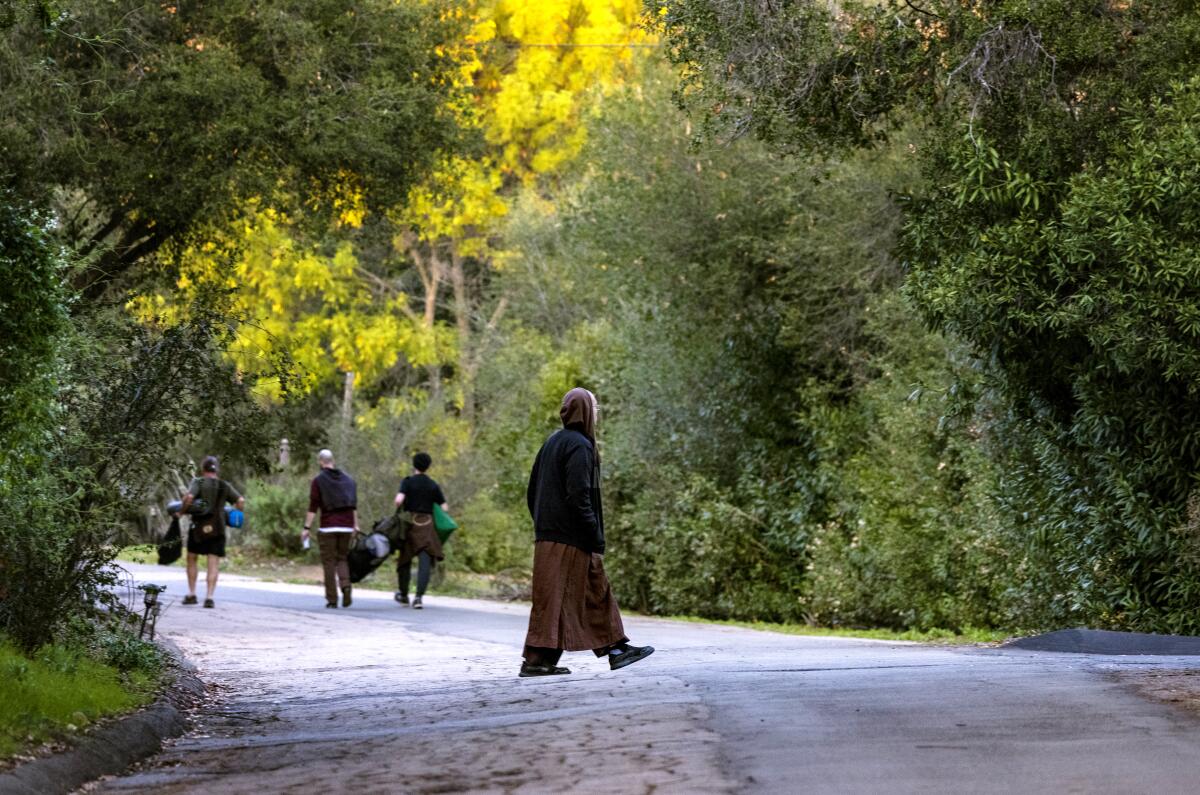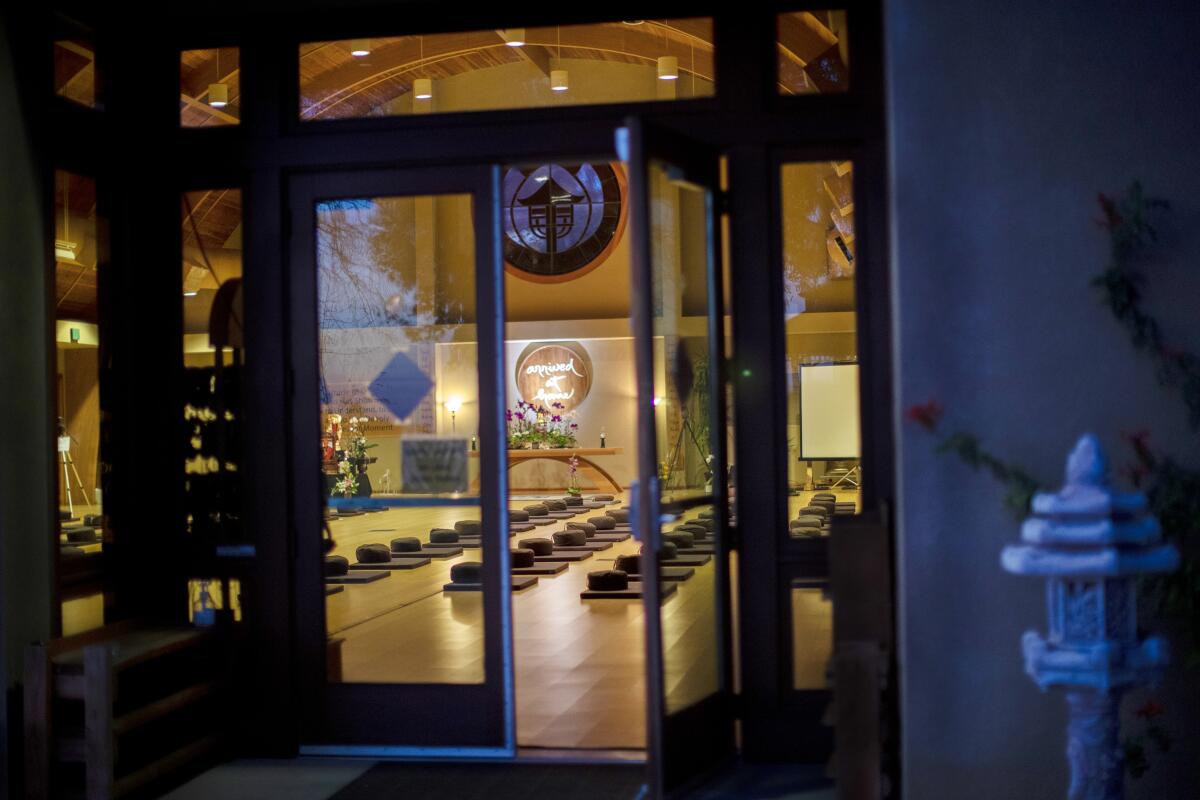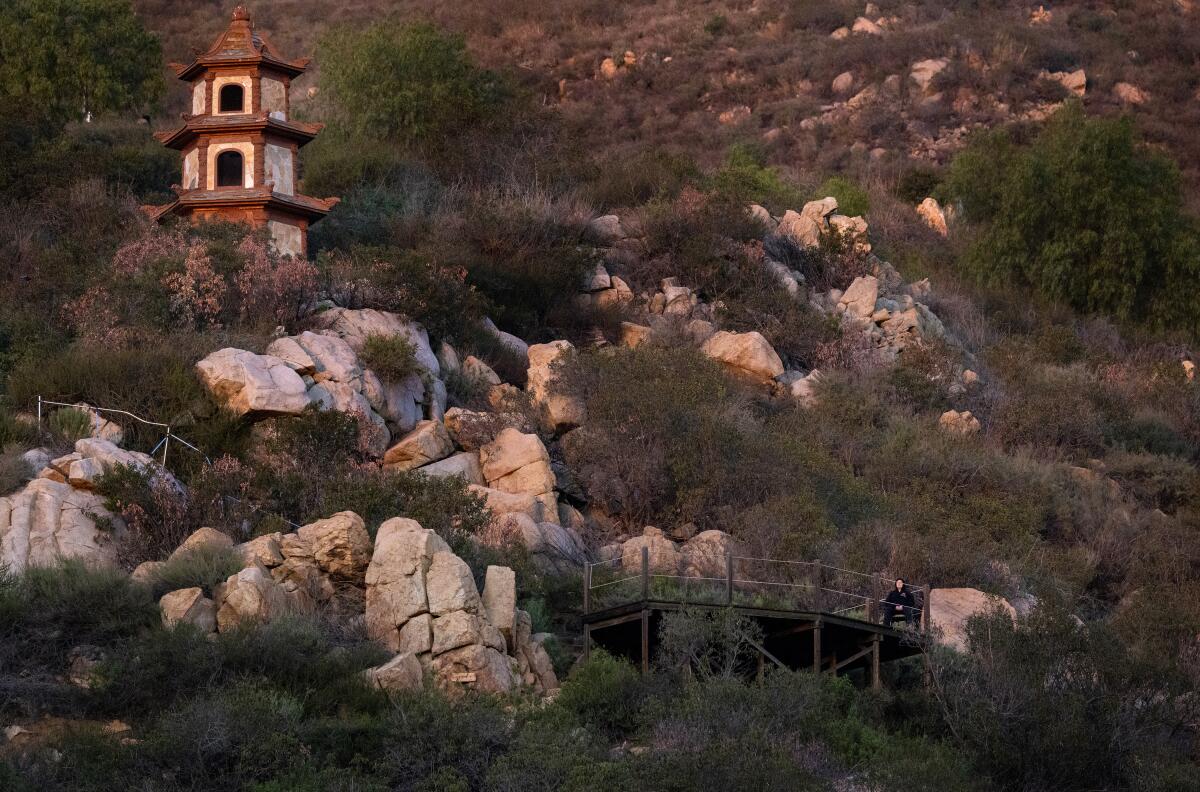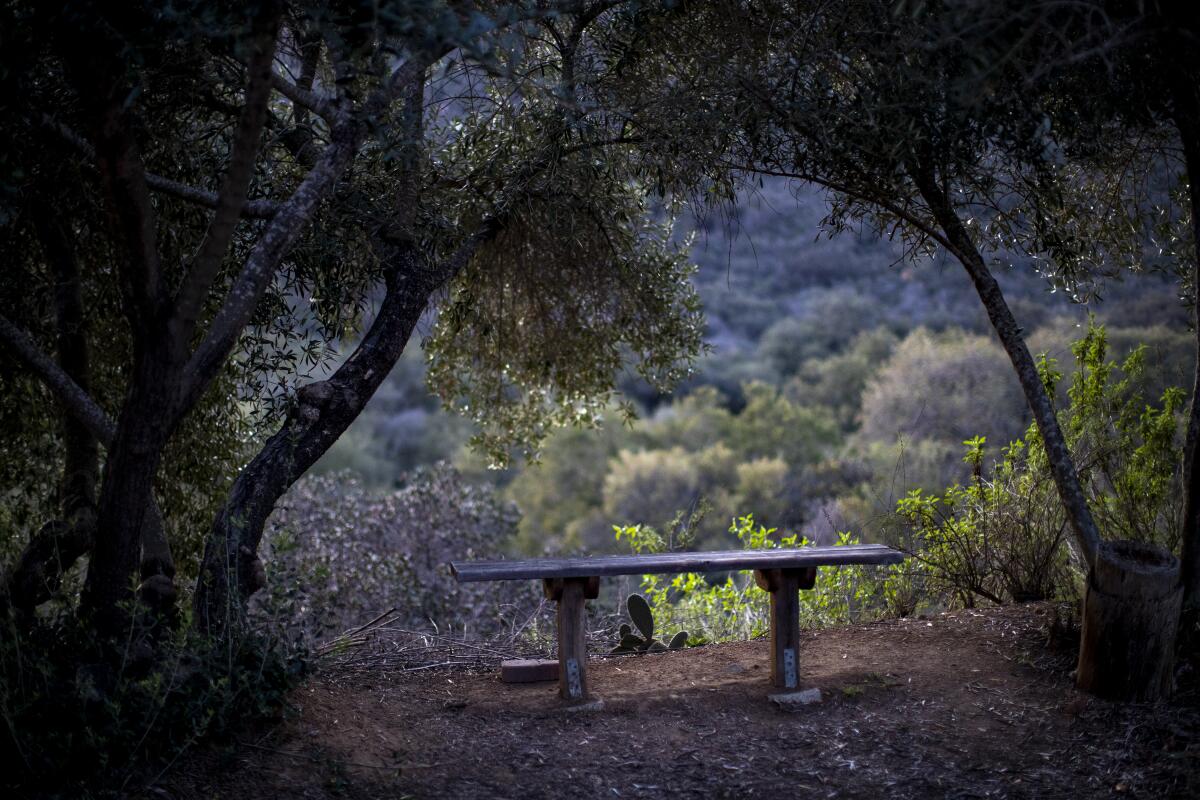‘A cloud never dies:’ A California monastery mourns mindfulness advocate Thich Nhat Hanh

- Share via
The low peaceful notes of a bell floated over the Deer Park Monastery in the mountains of Escondido, where hundreds of people gathered over the past few days to honor the beloved Zen teacher and poet Thich Nhat Hanh.
Nhat Hanh, who died last week at the age of 95, never lived at the mountain monastery he founded in 2000, but he visited many times to lead retreats.
Devotees say they can still see their teacher in the rustling of the wind through the oak trees, or in the form of a rock where he once gave a talk. Dotted throughout the property are small wooden signs painted in his distinctive calligraphy with gentle reminders to live fully, and joyfully, in the moment: “I have arrived, I am home.” “Peace is every step.” “Enjoy breathing.”
Hovering over the entrance to the monastery, a new banner erected this week waves in the afternoon breeze as a dozen monks clad in orange, saffron and brown robes head toward the meditation hall. It reads, “A cloud never dies.”
“That’s the theme of the seven-day service we are holding for our teacher,” said Brother Phap Dung, a dharma teacher at the monastery. “It means our teacher doesn’t die, he just manifests differently now. The cloud becomes rain, becomes grass, becomes tea. He’s not dead now, he’s just in a different form.”

Nhat Hanh’s death was not unexpected — he had a stroke in 2014 that left him unable to speak, and his health had been in decline over the past few years. But his death was still painful for many of his followers.
“Everyone can feel the loss, that’s for sure,” said Bang Lang Do, a pianist in Orange County who attended her first retreat with Nhat Hanh in 1984. “But he’s already explained so many times in his dharma talk to look for him in the flowers, to look for him in the monks and nuns, and to look for him in the essence of who he was and to see how he has transformed into all these wonders.”
The grief comes in waves, she says, but Nhat Hanh, lovingly called “Thay” (teacher in Vietnamese) by his followers, prepared her to handle it.
“Of course, when you are sitting down to meditate, feelings will arise, and many of us did cry, but the practice is at the moment of your crying to get ahold of your breath again, and say, ‘This is how I’m feeling now, this is how my heart is beating,’” she said. ”To be able to soothe yourself and recognize that emotions and thoughts will pass is a great tool to have.”
Born Nguyen Xuan Bao in central Vietnam in 1926, Thich Nhat Hanh was among the most influential Buddhist teachers of his time, helping to spread the practice of mindfulness across the globe.
Martin Luther King called him “an apostle of peace and nonviolence” when he nominated him for the Nobel Peace Prize in 1967 for his work opposing the Vietnam War. The novelist Alice Walker described him as “the most beloved Buddhist teacher in the West.” Spiritual author Deepak Chopra said he was a gift to humanity.
“Not only did he bring mindfulness to the world in a very gracious way, he was the total embodiment of it,” Chopra said in an interview with The Times. “His presence was so peaceful that everyone around him felt peaceful, just by his presence.”
Nhat Hanh defined mindfulness as the practice of being fully aware of what is going on in the present moment.
“When you breathe in, and you know that you are breathing in, that is called mindfulness of breathing,” he said in a talk in 2007. “When you drink your tea, and if you are aware that you are drinking your tea, that is called mindfulness of drinking.”
He taught that mindfulness can be practiced every moment of our lives — when we are sad, joyful, or angry, when we are cooking, driving, or about to send an email.
Ultimately, he taught that the diligent practice of mindfulness can lead to insight about the nature of the world, which can in turn liberate us from anger, fear, and despair.
“Our teacher doesn’t die, he just manifests differently now.”
— Brother Phap Dung, a dharma teacher at the Deer Park Monastery
“When your mind is more spacious, you begin to see more clearly and all of a sudden you have an ah-ha moment,” Dung said. “The salvation comes from that understanding of why you continue to do what you do, and why others do what they do.”
In the past few decades mindfulness has exploded in the United States, becoming a $1-billion industry. Secular mindfulness, based on the Mindfulness-based stress reduction program, was pioneered by one of Nhat Hanh’s students, the scientist and author Jon Kabat-Zinn. Today, it’s taught in elementary schools, hospitals, businesses, and by the military to help reduce anxiety and increase concentration. Numerous scientific studies have shown the benefits of mindfulness for alleviating depression, lowering blood pressure, and even relieving back pain.
Nhat Hanh wasn’t the first Buddhist monk to bring mindfulness to the West, experts say, but his prolific teachings in books like “The Miracle of Mindfulness” and “Peace is Every Step” had a tremendous influence on the industry.

“A lot of the meditation teachers and dharma teachers teaching mindfulness today have studied with him or been on retreat with him or read his books,” said Kaira Jewel Lingo, a dharma teacher and former monastic at Plum Village, Nhat Hanh’s monastery in southern France. “They were some of the earliest to be translated in English in the ‘70s and ‘80s and they are still widely quoted and considered classics.”
Nhat Hanh’s messages resonated so universally in part because he embodied his teachings of mindfulness, interconnectedness, and what he called engaged Buddhism, said Duncan Williams, professor of religion and East Asian languages and cultures at the University of Southern California.
“It’s one thing to talk about having stillness in the middle of chaos and difficulty in a theoretical, or abstract, kind of way, but because he comes from the ravages of war, when he talks about it, it’s a very rooted, embodied thing,” he said. “When he teaches on kindness and seeing yourself in your enemies it has a certain ring to it that sounds true.”
(After watching video of police beat up Rodney King, Nhat Hanh wrote an op-ed for The Times in 1991 titled “We are the beaters; we are the beaten” that illustrates his ability to see himself equally in the victims of violence and those who perpetrate it.)
Nhat-Hanh was also a uniquely gifted communicator.
“He’s a poet in addition to being a meditation master, and he could take very complex texts and the deepest wisdom in the Buddhist tradition, and find clear simple ways of communicating the profundity of the teachings,” Williams said. “Not every great Buddhist teacher had that poetic element.”

While Nhat Hanh’s teachings informed the secular mindfulness movement, his followers and admirers say the mindfulness he taught in his books and at the many retreats he led around the world was something different.
“I wouldn’t say he had an interest in secularizing it,” Duncan said. “He always believed mindfulness was a spiritual thing. For him, mindfulness was all about connecting to oneself and all sentient beings of the world, and the moral dimension of becoming aware of that interbeing.”
Dung put it this way: “When you are mindful, you remember that other people suffer, and you are also suffering, and then what are you going to do about it? ‘Peace in oneself, peace in the world,’ is our teacher’s phrase.”
Living this way sounds simple, but it takes tremendous effort and presence of mind to actually put it into practice.
“Simple to say, not so simple to live it,” Do, the pianist, said.
To help his community immerse itself in mindfulness practice, Nhat Hanh established 11 practice centers and monasteries around the world where the lay community can spend a day, weekend, week or more on retreat from the pressures of daily life. Deer Park is one of those centers.
“I call it a refugee camp from urban warfare,” Dung said. “At the monastery we hold this place where people come to recharge, revive and refine their purpose. The monastery is like a river — it’s always there, and people take what they need.”
Deer Park is beautiful, but it’s not fancy. Overnight visitors sleep in dormitories or camp on the grounds. The buildings are old and low slung. After Nhat Hanh died, the monastics — 17 monks and about 20 nuns — tacked yellow signs in both English and Vietnamese throughout the property, inviting visitors to practice “noble silence” as a way to honor the teacher.
The monastery is not usually open to drop-in visitors on weekdays, but it has been this week, and visitors have come from all over Southern California to walk quietly in the gardens, or sit in the meditation hall with the monks and nuns. The seven-day Heart Recollection Retreat: Coming and Going in Freedom, which has also been streaming online, was concluding Friday.
The vibes at the monastery are contemplative, but not sad, Pham said.
“The ceremonies are helping us to bring alive our teacher’s energy and to make what we learned from him concrete,” Pham said. “Instead of mourning and sad, we are remembering what he taught us. We are fortifying ourselves so we can continue him.”
More to Read
Sign up for Essential California
The most important California stories and recommendations in your inbox every morning.
You may occasionally receive promotional content from the Los Angeles Times.











